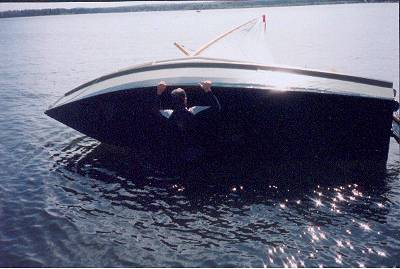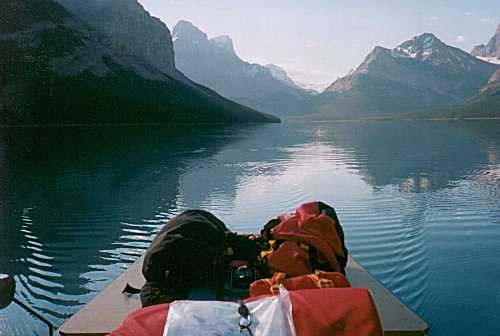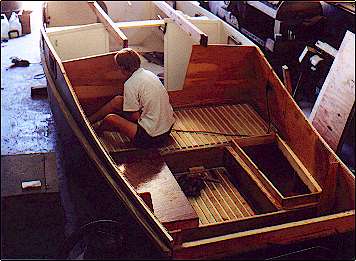
HERB MCLEOD'S RB42
Contents:
Contact info:
Jim Michalak
118 E Randall,
Lebanon, IL 62254Send $1 for info on 20 boats.
Jim Michalak's Boat Designs
118 E Randall, Lebanon, IL 62254
A page of boat designs and essays.
(15oct00) This issue presents thoughts about emergency flotation. Next issue, 1nov00, will discuss hatches and vents and such.
A VERY INTERESTING WEB SITE... is at Dave Bolduc's where Dave has photos and stories about his Matt Layden mini cruiser. Layden's boats have lots of interesting features to say the least. A while back in the great paper magazine Messing About In Boats builder Don Elliott wrote a long detailed series about building one, complete with wonderful illustrations. I'm still hoping he will write up a sailing report someday.
|
|
Left:
HERB MCLEOD'S RB42
|
|
|
Emergency Flotation
REMEMBER THIS PHOTO?...

Here Herb Mcleod is climbing up the bottom of his capsized AF3, putting his weight there which will pull the boat back upright. What I want to point out here is that the boat is floating high on its side on purpose - it is designed to do that. The cabin is watertight except for the top opening, which is on centerline and well above the sideways waterline. Similarly there is a buoyancy/storage box in the stern to float that end high, and like the cabin, its centerline hatch is well about the sideways waterline. So the cockpit floods a bit but the cabin and stern box stay dry and float her high on her side as the boat waits for you to put your weight on the leeboard and pull everything upright again. There are other ways to do emergency flotation.
THE SAMPLE BOAT...
Figure 1 shows the "boat" I will use in the examples. It's not much of a boat but has the overall size of a small sailer. Its main attribute is that, being rectangular in every way, it makes figuring volumes in the coming examples very simple.

The boat weighs 100 pounds and is intended to float two people who together weigh 300 pounds. So the total floating weight is 400 pounds. Since fresh water is supposed to weigh 62 pounds per cubic foot, the boat will displace about 6.5 cubic feet of fresh water. On this hull that occurs when the hull sinks 2.2" into the water at level trim. (The density of sea water varies but is usually about 5% greater than fresh, so the draft of the boat there would be about 5% less)
CAPSIZE!...
Figure 2A shows the open hull knocked on its side and flooded. The crew has abandoned ship. An open wooden hull with no ballast or extensive use of metal parts should float about half in and out of the water when on its side. Here is why. The density of dry wood is usually about 30 pounds per cubic foot, about half the density of water. So this 100 pound wooden boat has about 3.3 cubic feet of wood in it. If completely submerged, that would displace 3.3 cubic feet of water or about 200 pounds worth. Half submerged it would displace 100 pounds of water, that is, the weight of the empty boat. And that is where it would want to float on its own.

Anyone who weighs more than 100 pounds trying to sit on top of the swamped hull in this attitude will completely push the boat under. (But if this were a heavily planked boat weighing 300 pounds with 10 cubic feet of wood, we'd have over 600 pounds of displaced water when completely submerged. That would float the heavy boat plus a big man on top of the swamped hull.)
Look at Figure 2B. here the boat is being righted without anyone depressing the hull with their weight. Half of the structure stays submerged in the process. She'll roll up one quarter full, about 12 cubic feet of water on board, about 750 pounds worth! Sometimes if you try to retrieve a flooded hull like this it will collapse from the weight of the water.
Many boats are righted after capsize by placing crew weight on the centerboard and that weight depresses the hull such that much more water is taken on and the righted boat can be awash. The problem can be compounded by an open centerboard or daggerboard case which doesn't come up to the level of the rails. The open top may be submerged in the swamped hull and water can stream in freely as you try to bail.
As I recall L. Francis Herreshoff once wrote about reboarding a flooded pram. Swim alongside and bail with your hat. Or shove the swamped boat hard forward while swimming to make trapped water surge over the stern. Then reboard over the stern. I think he used the word "heartbreaking" somewhere in the procedure.
It's interesting to speculate about what happens if you rotate the capsized hull to the inverted position as in Figure 2C. It looks like an air pocket of one quarter the hull's volume will be trapped, that is about 750 pounds of potential buoyancy, enough to float everyone high and dry if the boat can be kept from rolling and letting the air out.
STABILITY...
If you have the buoyancy needed to float everyone in the recovered boat, you may not have sufficient stability to reboard. Here is what happens. As you grab the rail and try to pull yourself up into the boat, you heel the hull to your side. That causes the free water in the recovered boat to slosh to your side and with it comes its considerable weight. The heel will continue to increase. The rail may go under and recapsize the boat. I think by the best solution is to reboard over the stern. You.ll likely need a well thought out ladder or toehold to do that. Sometimes the rudder can be rigged to be a step.
END BOX FLOTATION...
Next try an improvement. Figure 3 shows the boat fitted with water tight air boxes in each end, each 3' long such that only half the boat is open. We'll assume the weight stays at 100 pounds.

Now what happens in a knockdown?
Floating on its side with no crew weighing her down she will sink only 2.5" instead of the 18" of the open boat!
When righted that 2.5" will amount to about 100 pounds of water, about 1/7th of the water in the open boat. It's about 12 gallons that will need to be bailed. You could easily reboard and sail with that much water on board if the stability of the sloshing water were not a problem. But it probably would be. I think my first try would be to reboard over the stern, bail the water and bring on the passenger.
The end boxes have a huge volume and buoyancy. They will float about 700 pounds each. You can climb on board the upset hull from either end and it will stay pretty level. You can't submerge it with your weight. But if you try to do the same job with a single box, say in the bow alone, she may try to float straight up and down like a buoy. She may be very difficult indeed to recover.
This system of end boxes is my current favorite. I use the end boxes as storage volumes with access provided by narrow covered hatches on centerline. My customers like to make the hatches bigger and bigger but one must remember that even though the hull is floating in just a few inches of water, a big wave can come along and slop into your hatches and there goes your flotation. The big open space between the boxes makes a good cockpit and sleep spot.
BOTTOM BOXES
What if we put the air box in the bottom half of the boat instead of in the ends, as in Figure 4? If we make a double bottom 9"above the real bottom the capsized boat will float 2.5" deep on it's side as before.

But when the hull is righted, it works out that a lot less water remains on board than in the previous example. In fact with this layout ther is no reason to not put drain holes trhough the side just above the double bottom and let the trapped water drain out on its own. The volume between the bottom and double bottom would displace close to 1500 pounds, plenty for you and your crew. Your boat is one step away from being a Sunfish type, that is totally decked and water shedding.
I see some problems with the bottom box setup. Rot might be a trouble in a wooden hull because the narrow volume may be hard to ventilate. Also the low narrow volume may not be a friendly place to stow gear.
And it might be heavy. The deck must be stiff and strong enough to support the crew. The previous example didn't have that problem because crew weight is also supported by the water direclly below the bottom and the end decks need not support any crew.
I've seen several fiberglass boats that used solid foam slabs to effect a solid double bottom. That had large openings in the transoms to drain any water. I've seen some with no transoms at all! In truth these boats are really foam boards with fiberglass streamlined bump shields. But watch out. Foam weighs more than people realize in the volumes needed. In the baby barge example we'd have 24 cubic feet of it - maybe 60 pounds and a 60% increase in bare boat weight.
SIDE BOXES...
What if we put the emergency flotation volume in the sides of the hull as in Figure 5?

On its side this empty hull will float in just over an inch of water! If the crew hops onto the sideways boat she will sink down less that six inches provided the side boxes are at least that deep. And when righted there will not be a drop aboard. She's ready to go.
This setup is often seen on side decked daysailers that were common in years past. Those boats usually didn't really have boxes along the side decks but if water doesn't slop over the edge of the decks the effect is the same. Sometimes these boats can have air bags or slabs of foam secured under those side decks just in case.
Deep side boxes cut into the living space of a boat and that can sometimes be a problem. In a narrow boat it usually means the crew must sit on top of the boxes instead of down inside the hull. It works fine in some cases allowing for comfortable hiking.
Birdwatcher type cabin sailers use this side box system very effectively. Wide side decks are raised above the heads of the low seated crew, who now view the world through watertight plastic windows. The crew's low down weight and high wide side decks make this type of boat about unswampable even without ballast. There are no boxed chambers and all the interior volume is usable.
EFFECTS OF HULL SHAPING...
Unlike my sample barge, most real hulls have pointy ends. In every scheme of flotation I've mentioned, the pointed ends would take away some airbox volume. So I'd expect the emergency flotation to be decreased over the barge case. In addition, pointed ends can reduce the volume in those extremes and make reboarding over the ends riskier.
However, the effect of a sweeping sheer is usually quite good for swamped stability. Air boxes in the hull's ends are well above the swamped center. Roll will be resisted and even if the rail goes under, she should roll upright again. She may refuse to stay inverted. But a hull with double bottom may behave the opposite way. That may be more stable belly up than down.
NEXT TIME...
I'll continue with a related topic about hatches and openings in your boat.
RB42

RB42, ROWBOAT, 18' X 45", 120 POUNDS EMPTY
Herb McLeod, who built the first RB42, lives in Edmonton, Alberta and likes to tease the rest of us with photos like the one above. Beautiful! Here is his RB42 out camping with two aboard.
RB42 is a row boat for two! Look closely and you will see a lot of my Toto canoe in RB42. I has the same long lean bow and multichines for smoother going in rough water. The stern is wider on top but the lines of these boats at the water always sweep upward and taper to nothing. The stern has a buoyancy/storage volume with a hatch. The bow has another buoyancy/storage area with access through a deck plate in the bulkhead.

Here is another one of Herb's camping photos. You can see some gear lashed to the aft deck and no doubt there is a lot more stuff secured inside that stern locker. The floor of the boat is about 10' long and totally open so one person could sleep there right in the boat. There are no built in seats or frames in the way. A movable rowing seat is used. Here is Herb's version:

A thinly padded board is mounted to a standard plastic toolbox. The seats shouldn't be too high, I've usually made mine about 9" high but that would vary by person and boat so some experiments are needed on the trial runs. As I recall, Herb's seat has a little trick to it - the seat is actually attached to the bottom of the box. So if the box is turned over, the top is available and it can be used then as a regular tool box.
Although designed to be rowed by two people, this boat might be fine with a solo rower in many conditions. The long waterline should give extra speed over a shorter boat, although it's not all that simple. Frictional area might be increased and windage drag should increase over a shorter boat. But RB42 is a bit lower and sleeker than my other designs so it's hard to tell.

Herb had to tinker a bit with the seating and oarlock locations, something any rowboat builder will likely have to do. In the end he moved the locks aft 1' from what is shown in the first photo. Solo rowing is fine from what is shown above as the original aft location. Seating in almost all my rowboats is on movable boxes that simply rest on the floor so no revisions of seating structure was needed. In addition when the seat boxes are removed, the boat is totally open between the bulkheads. I got the idea a long time ago from reading Bolger, who got the idea from Herreshoff.
RB42 is built with taped seams from three sheets of 1/4" plywood and three sheets of 3/8" plywood. No lofting or building jigs required. Plans are $20
Prototype News
Some of you may know that in addition to the one buck catalog which now contains 20 "done" boats, I offer another catalog of 20 unbuilt prototypes. The buck catalog has on its last page a list and brief description of the boats currently in the Catalog of Prototypes. That catalog also contains some articles that I wrote for Messing About In Boats and Boatbuilder magazines. The Catalog of Prototypes costs $3. The both together amount to 50 pages for $4, an offer you may have seen in Woodenboat ads. Payment must be in US funds. The banks here won't accept anything else. (I've got a little stash of foreign currency that I can admire but not spend.) I'm way too small for credit cards.
Here are the prototypes abuilding that I know of:
Caprice: A brave and experienced builder in Texas is making the 25' Caprice water ballasted sailboat. A big project.Here the builder plugs away at the aft deck.

Jon Jr has been completed by Joe Leinweber and Dan Ellis and tested to a certain degree. Click here to read about the test and the surprize ending! ("The waters are only safe until next time!")

Mayfly12: A Mayfly12 is now completed and has been sailed. Waiting for final photos but here is an initial photo.

AN INDEX OF PAST ISSUES
Herb builds AF3 (archived copy)
Hullforms Download (archived copy)
Plyboats Demo Download (archived copy)